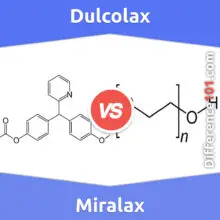The human body is a complex system that relies on a delicate balance of hormones and processes to maintain optimal health and functioning. Two important hormones involved in regulating the body’s fluid and electrolyte balance are ADH and aldosterone. Both hormones play crucial roles in maintaining the body’s hydration levels, but they have distinct functions and origins. ADH, or antidiuretic hormone, is produced by the hypothalamus and released by the posterior pituitary gland. On the other hand, aldosterone is produced by the adrenal glands and plays a key role in regulating electrolyte levels, particularly sodium and potassium. While both hormones are essential for the body’s overall well-being, understanding the differences between them is crucial for maintaining a healthy fluid balance. In this article, we will explore the key differences between ADH and aldosterone and how they work together to maintain the body’s fluid and electrolyte balance.
Table of Contents
What Is Adh?

ADH, or antidiuretic hormone, is a crucial hormone that plays a vital role in maintaining the water balance within the body. Produced by the hypothalamus and released by the posterior pituitary gland, ADH works to regulate the amount of water excreted in urine. This is achieved by increasing water reabsorption in the kidneys, resulting in a concentrated urine and conservation of water. ADH release is carefully controlled by factors such as blood osmolarity and volume, ensuring that the body maintains a proper balance of fluids. Its key role in conserving water makes ADH an essential hormone in situations where the body needs to preserve fluid, such as during dehydration.
What Is Aldosterone?

Aldosterone is a hormone that is produced by the adrenal glands, specifically in the outer layer known as the adrenal cortex. Its main function is to regulate the body’s electrolyte balance, with a focus on sodium and potassium levels. This hormone primarily acts on the kidneys, where it increases the reabsorption of sodium ions and the excretion of potassium ions. These actions are crucial in maintaining normal blood pressure, blood volume, and electrolyte concentrations in the body. The release of aldosterone is influenced by various factors, including blood pressure, blood volume, and potassium levels. It is a vital component of the renin-angiotensin-aldosterone system, which is a complex regulatory mechanism for blood pressure and fluid balance.
Key Differences Between Adh And Aldosterone
Adh (ADH, or antidiuretic hormone) and Aldosterone are two important hormones that play crucial roles in maintaining the body’s fluid and electrolyte balance. While both hormones act on the kidneys to regulate water and sodium levels, there are key differences between them. ADH is produced by the hypothalamus and released by the posterior pituitary gland, while Aldosterone is produced by the adrenal glands. ADH primarily regulates water reabsorption, whereas Aldosterone focuses on sodium reabsorption. Additionally, ADH release is tightly regulated by factors such as blood osmolarity and volume, while Aldosterone is regulated by the renin-angiotensin-aldosterone system. Understanding these key differences is crucial in comprehending the complex mechanisms of our body’s homeostasis.
- Adh is produced by the pituitary gland.
- Aldosterone is produced by the adrenal glands.
- Adh regulates the balance of water in the body.
- Aldosterone regulates the body’s electrolyte balance, particularly sodium and potassium levels.
Adh vs. Aldosterone Similarities
Both ADH and Aldosterone are hormones that play important roles in regulating the body’s fluid and electrolyte balance. They are both produced by glands in the body – ADH by the hypothalamus and released by the posterior pituitary gland, and Aldosterone by the adrenal cortex. These hormones act on the kidneys to increase the reabsorption of water and sodium, respectively, in order to maintain proper levels in the body. They are both tightly regulated by factors such as blood osmolarity and volume, and their release is crucial in situations where the body needs to conserve fluids and maintain electrolyte balance.
- Both hormones act primarily on the kidneys.
- They are both produced by glands in the body.
- They are both tightly regulated by factors such as blood osmolarity and volume.
Adh vs. Aldosterone Pros and Cons
Adh Pros & Cons

Adh Pros
Antidiuretic hormone, also known as ADH, is a vital hormone that plays a crucial role in regulating the body’s water balance. Produced by the hypothalamus and released by the posterior pituitary gland, ADH has numerous advantages and pros. Firstly, it helps to conserve water by reducing the amount of water excreted in urine through increasing water reabsorption in the kidneys. This is particularly beneficial in situations where the body is dehydrated and needs to conserve fluids. Additionally, ADH release is tightly regulated by factors like blood osmolarity and volume, ensuring that the body maintains a healthy balance of water. Overall, ADH is a vital hormone that helps to maintain the body’s water balance and ensure optimal functioning.
- It helps to conserve water by reducing the amount of water excreted in urine through increasing water reabsorption in the kidneys.
- This is particularly beneficial in situations where the body is dehydrated and needs to conserve fluids.
- ADH release is tightly regulated by factors like blood osmolarity and volume, ensuring that the body maintains a healthy balance of water.
Adh Cons
Despite its crucial role in regulating the body’s water balance, ADH (or antidiuretic hormone) also has its disadvantages and cons. One of the main drawbacks of ADH is its potential for overproduction, leading to a condition known as syndrome of inappropriate antidiuretic hormone (SIADH). This can cause excessive water retention, resulting in swelling, low sodium levels, and potentially serious health complications. In addition, certain medications and medical conditions can interfere with ADH production and release, causing imbalances in the body’s water levels. Furthermore, overproduction of ADH can also be a sign of underlying health issues, such as tumors or infections. Therefore, while ADH is essential for the body’s functioning, its proper regulation is crucial to avoid potential disadvantages and complications.
- ADH is its potential for overproduction, leading to a condition known as syndrome of inappropriate antidiuretic hormone (SIADH).
- Сertain medications and medical conditions can interfere with ADH production and release, causing imbalances in the body’s water levels.
- Overproduction of ADH can also be a sign of underlying health issues, such as tumors or infections.
Aldosterone Pros & Cons

Aldosterone Pros
Aldosterone is a vital hormone produced by the adrenal glands that plays a crucial role in maintaining the body’s electrolyte balance. This hormone acts on the kidneys, promoting the reabsorption of sodium ions and excretion of potassium ions, ultimately regulating blood pressure, blood volume, and electrolyte concentrations. One of the main advantages of aldosterone is its ability to regulate blood pressure and fluid balance through the renin-angiotensin-aldosterone system. This system is responsible for maintaining stable blood pressure levels and preventing imbalances in electrolytes. Aldosterone also helps to conserve sodium, which is essential for maintaining proper nerve and muscle function. Overall, the proper functioning of aldosterone is crucial for maintaining overall health and wellness.
- This hormone acts on the kidneys, promoting the reabsorption of sodium ions and excretion of potassium ions, ultimately regulating blood pressure, blood volume, and electrolyte concentrations.
- Aldosterone is its ability to regulate blood pressure and fluid balance through the renin-angiotensin-aldosterone system.
- This system is responsible for maintaining stable blood pressure levels and preventing imbalances in electrolytes.
Aldosterone Cons
The production and release of aldosterone, a hormone primarily produced by the adrenal glands, is an essential process for maintaining electrolyte balance and regulating blood pressure in the body. However, there are also several disadvantages and cons associated with this hormone. One major disadvantage is that excessive aldosterone production can lead to high blood pressure, which can increase the risk of heart disease. Additionally, aldosterone can cause the retention of fluid, potentially leading to edema and swelling. Other potential negative effects include electrolyte imbalances, muscle weakness, and fatigue. Moreover, certain medications and conditions can disrupt the normal function of aldosterone, causing further complications. Therefore, it is important to carefully monitor aldosterone levels and address any abnormalities to prevent potential health disadvantages.
- Aldosterone production can lead to high blood pressure, which can increase the risk of heart disease.
- Aldosterone can cause the retention of fluid, potentially leading to edema and swelling.
- Other potential negative effects include electrolyte imbalances, muscle weakness, and fatigue.
Comparison Table: 6 Key Differences Between Adh And Aldosterone
| Components | Adh | Aldosterone |
|---|---|---|
| Production and Release | ADH, also known as vasopressin, is produced in the hypothalamus and released from the posterior pituitary gland in response to changes in blood osmolarity or decreased blood volume. | Aldosterone is produced and released by the adrenal cortex, specifically in response to changes in blood pressure and sodium levels. |
| Target Tissues | ADH primarily acts on the kidneys to increase water reabsorption in the renal tubules, reducing urine output and conserving water. | Aldosterone primarily acts on the kidneys, particularly on the distal tubules and collecting ducts, to increase sodium reabsorption and potassium excretion. |
| Stimulating Factors | ADH is released in response to high blood osmolarity, low blood volume, and various stressors that activate the hypothalamus. | Aldosterone release is stimulated by low blood sodium levels (hyponatremia) and a decrease in blood pressure. |
| Function | ADH regulates the body’s water balance by increasing water retention and reducing urine output, which helps to prevent dehydration. | Aldosterone primarily regulates electrolyte balance, particularly sodium and potassium levels, by enhancing sodium reabsorption and potassium excretion. |
| Effects on Urine | ADH decreases urine volume by promoting water reabsorption, resulting in more concentrated urine. | Aldosterone affects urine composition by increasing sodium reabsorption and potassium excretion, which can lead to a decrease in urine sodium and an increase in urine potassium levels. |
| Mechanism of Action | ADH acts on the renal tubules by inserting aquaporin channels in the cell membranes, facilitating water reabsorption. | Aldosterone acts on the distal tubules and collecting ducts by increasing the activity of sodium-potassium pumps, leading to sodium reabsorption and potassium excretion. |
Comparison Chart

Comparison Video
Conclusion: What Is The Difference Between Adh And Aldosterone?
In conclusion, while both ADH and aldosterone play important roles in regulating the body’s fluid and electrolyte balance, they differ in their specific functions and mechanisms of action. ADH works to conserve water by increasing its reabsorption in the kidneys, while aldosterone primarily targets sodium and potassium levels. Both hormones are tightly regulated by the body’s internal processes, emphasizing the crucial role they play in maintaining homeostasis. Understanding these differences can provide valuable insights into the body’s complex regulatory systems.







